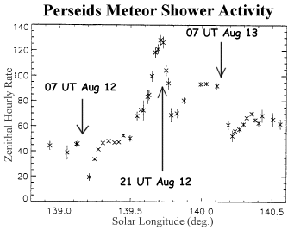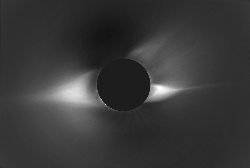Click on image for full size
Courtesy of NASA
Related links:
Watch Out for the Meteors!
News story originally written on August 10, 1999
This week's solar eclipse isn't the only thing to watch! The annual Perseid meteor shower will peak on August 12-13, 1999. There could be as many as 150 "shooting stars" per hour. Scientists say the best time to see this spectacular event is a few hours before dawn. However, the meteors should be visible all night long, starting at dusk.
These brilliant flashes of light will seem to originate from the constellation Perseus. It is best to lay down on the ground and face north to see the shower. Although they appear to come from the same point in space, they will be visible all over the sky.
Meteors are small fragments that broke off a comet. This particular shower came from Comet Swift-Tuttle, which orbits the Sun once every 135 years. Swift-Tuttle will not be visible from Earth until 2126. Fortunately, we have this great shower every year in August!
Typical meteors are the size of a grain of sand. They make up for their size with their speed. These meteors average 130,000 miles per hour! But don't worry, the particles burn up long before they reach Earth. A particle's high speed causes a large amount of friction between the meteor and Earth's atmosphere. The result is a burned up meteor!
The shower will be visible for most of the Northern Hemisphere. If you live below the equator, I'm afraid that very little, if any at all, will be seen. Fortunately, NASA will provide a live broadcast of the event on the web. They'll fly a balloon into the stratosphere with a video camera. So, no matter where you live, you can witness one of the more fascinating astronomical events!















